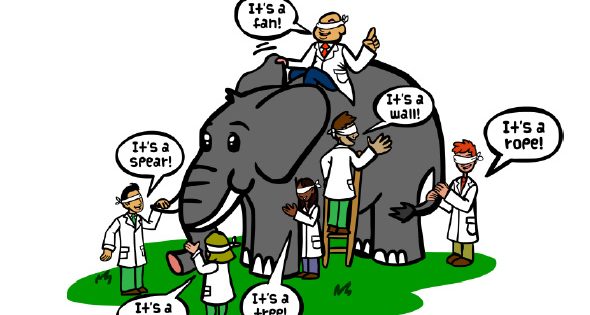Getting to the reasons for behavior changes and problems requires cooperation among pet owners, veterinarians and behavior and training professionals. Remember the story of the 3 blind men and the elephant? None of them could identify what animal they were touching because each of them was touching a different part of the creature. It was only when they shared information that they were able to figure out it was an elephant. Veterinarians, owners and behavior and training pros can be in the same boat – each may have an incomplete picture of the pet without input and information from the other two.
Here are three tips to help increase cooperation and communication resulting in better behavior care for our four legged family members.
1. Get in the habit of describing behaviors during conversations and in record keeping, before interpreting them. While we’ve talked about this before, its importance can’t be over-emphasized. Interpretations can be subtle and it’s easier to slip back into them than we might think. Fido likes chicken, Shep is good with children, Sammy doesn’t like his feet touched are all interpretations. Owners may think their dogs are good with children because they go lie down as far away from the kids as possible. A recent news article mentioned exactly that – how parents of a child who was bitten in the face interpreted their dog’s behavior prior to the bite. Imagine you are painting a verbal picture of what the pet is doing in as much detail as possible.
2. Use an owner’s intuition as the basis for further investigation. Pet owners who are providing a good quality of life for their pets know their pet better than anyone. Owners can’t be expected to have the professional, advanced knowledge to know the significance of certain behaviors or behavior changes, but because they spend more time observing their pets than trainers, behaviorists, or veterinarians ever could, they pick up on subtle changes. Sometimes, an owner will just have a sense that something isn’t right, or the pet seems “off” somehow. It’s our job as professionals to help owners identify what behaviors and what changes are contributing to that feeling or conclusion. If we discount or ignore owners’ concerns, chances are we are going to miss something important or delay finding out what’s wrong.
3. Respect each other’s expertise, share information, and ask good questions. Just like the three blind men, each of us – veterinarians, behaviorists, trainers, and pet owners – won’t be able to see the big picture without input from the rest. The blind man touching the elephant’s trunk had no idea what its leg felt like and vice versa. We each excel in our chosen area and better outcomes for pets can be achieved when we combine expertise rather than assuming we know what the other expert knows.
We have so many resources available to you that provide more in depth coverage and skill development for each of these tips. Just a few examples include:
- How To Write Professional Behavior Reports (PetProWebinars.com, and BEN Pro Member course)
- How to Take Behavior Histories And Increase Your Consulting Success (PetProWebinars.com, and BEN Pro Member course)
- Applying the Scientific Method To Track and Improve Your Behavior and Training Results (PetProWebinars.com)
- Increasing Veterinary Referrals: Professional Marketing Techniques for Trainers (Behavior Education Network Pro Member Course
- Appearances Can Be Deceiving: Are You Forgetting Behavior Changes Are the Most Common Symptom of Disease and Illness? (CAABChats.com)
- AND MORE!
If you can’t find any of these resources – or want to know MORE of what we have, just give us a call at 303-932-9095 or email us at Info@AnimalBehaviorAssociates.com and we’ll point you in the right direction!

Leave A Response